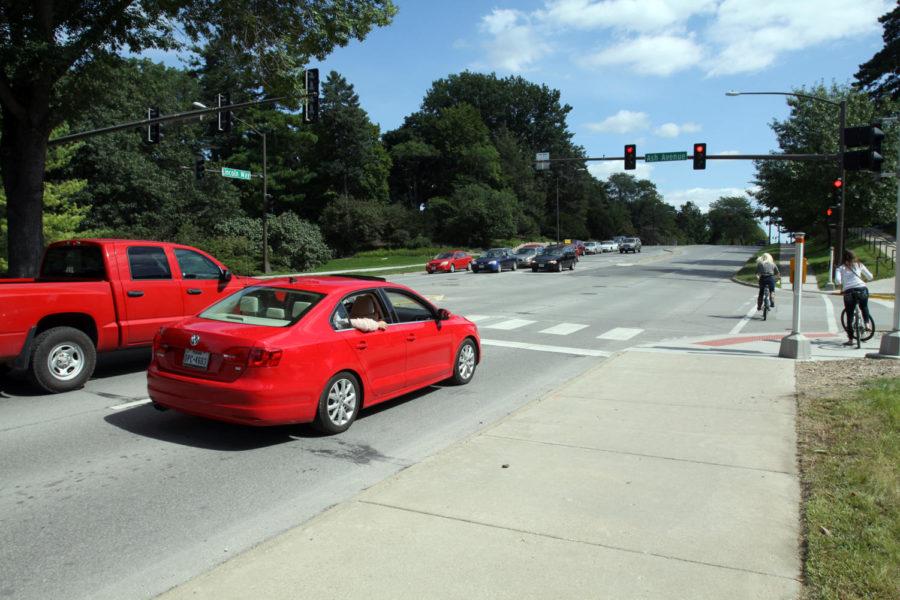City, university move forward with Lincoln Way safety study
Kyle Schlichting/Iowa State Dail
Several cars wait at the intersection of Ash Avenue and Lincoln Way on Sept. 14. The Ames Area Metropolitan Planning Organization is analyzing and updating the plans for many streets in Ames, including Ash Avenue and Lincoln Way. The organization is working toward enhancing the ability for bikes, cars, buses and pedestrians to get around the Ames community within the next 25 years.
March 28, 2016
Following the Ames City Council’s approval of a safety study, the city and university will begin working together to identify and address safety improvements along Lincoln Way.
The first phase of the study, with a budget of $31,841, includes data collection and analysis. The second phase, with a budget of $69,045, will “identify and evaluate traffic operations and/or physical modifications that address identified issues,” according to city documents.
City staff have begun recording traffic volumes, crossing and multimodal data along the Lincoln Way stretch between University Boulevard and Sheldon Avenue. They are expected to conclude the data collection by the end of the semester.
Upon completion of the data collection, SRF Consulting will be able to provide recommendations and strategies to improve pedestrian safety and congestion. The consulting firm has previously worked with the university on Osborn Drive to implement successful strategies, which have resulted in improvements.
Cathy Brown, program manger of facilities planning and management, said she hopes to see similar results along Lincoln Way.
Previous changes on Osborn Drive to accommodate increased enrollment have included widening sidewalks, removing street parking, educating students about the corridor and making changes on CyRide bus stop locations. Other solutions have included the Walk Your Wheels campaign, which helped decongest sidewalk traffic. Brown hopes to use their experiences to make appropriate parallel changes along Lincoln Way.
The public is encouraged to participate to help provide feedback, according to city documents. An online survey is soon to be released focusing on the following questions: What are issues/concerns that you have traveling across or along the Lincoln Way corridor? What would you suggest to resolve the issues/concerns you have?
Second, SRF and project managers are “identifying a working group comprised of representatives from Iowa State University, Student Leadership, and City of Ames staff.”
Third, after SRF has identified and presented alternatives to project managers and the working group, “a public information meeting will take place at the Memorial Union to review the alternatives.”
Fourth, SRF will present recommendations to administration, City Council and/or Student Government.
“As we collect data on Lincoln Way, we hope to better understand how people are crossing the streets,” Brown said. “Are they crossing in the middle of the block? What are the behaviors contributing to the complexities of that corridor?We have to be accountable — regardless if you’re the driver, bicyclist or pedestrian — that our community is safe.”
Increasing residential and commercial development has led to increasing pedestrian and multimodal transportation, said Warren Madden, senior vice president for business and finance. Buchanan 2 will add 700 to 800 residents along Lincoln Way, in addition to private apartment developments.
“The study seeks to find alternatives for improving pedestrian safety and crossing,” Madden said.
Accidents such as the hit and run that killed Emmalee Jacobs along Lincoln Way last semester have stirred community concern over pedestrian safety.
With increasing enrollment comes increasing challenges to determine and meet student needs. The university must determine where students are traveling as more classrooms and buildings are used on campus.
Some considerations include more classes in Hamilton Hall, where the Iowa State Daily was previously housed. Others include more College of Engineering classes in the applied science center and the expansion of Bessey Hall.
“Students are voting with their feet,” Madden said. “Based on the data I’ve seen, this coming fall, enrollment will be up again. More students are electing to come to Iowa State. Feet create pedestrian crossing problems on Lincoln.”
Madden said he hopes the study will lead to strategies that will make campus more convenient and efficient and alleviate midday congestion. By keeping residential and commercial areas within close proximity, it becomes more convenient for students and helps alleviate transit challenges, Madden said.
Thirty-three motor vehicle accidents involving pedestrians have been reported since Jan. 1, 2014, in Ames. Of those 33 accidents, 11 occurred along the Lincoln Way corridor, said Shari Berends, Ames Police Department records clerk.
Elizabeth Morse, ISU Police public safety clerk, said there have been no reported accidents with injuries involving pedestrians on Lincoln Way dating back to 2005.
Although possible solutions include physical changes — signalization, lighting patterns and overpasses — Madden acknowledges a need to raise awareness and educate everyone about their responsibility to stay safe.
“Distracted driving, distracted walking … all of those are issues,” Madden said. “Can we educate students to use better judgment and better safety procedures as they move around? We can only go so far in improving safety and educating people, and then there’s a place where individuals have to assume some responsibility for themselves.”

















